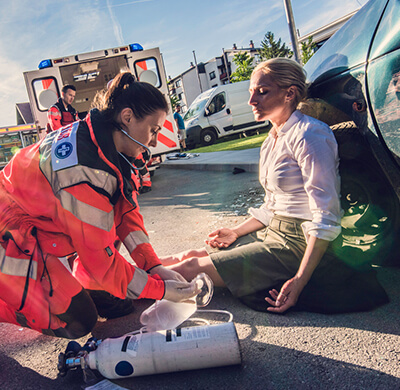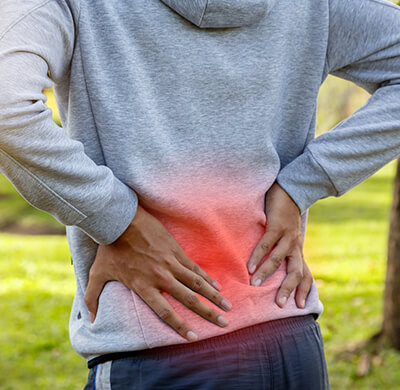Welcome to the Patient Education Library of Texas Medical Institute
Reverse Shoulder Replacement
Introduction
Reverse shoulder replacement is an advanced newer surgical treatment that was approved by the FDA in 2004. A reverse shoulder replacement is a surgical procedure to replace a damaged shoulder joint with an artificial one. The new joint stabilizes the joint to allow pain-free movement and function.
A reverse shoulder replacement is used for people with certain complex shoulder conditions. In contrast to total shoulder replacement surgery (shoulder arthroplasty), the components of the artificial joint are placed in reversed positions to allow the deltoid muscle at the shoulder to raise the arm. Like traditional total shoulder replacement, physical therapy following the procedure helps to ensure the best outcomes.
Anatomy
The shoulder joint has a greater range of motion than any other part of the body. Because the shoulder joint can perform so many movements, it’s structure of bones, ligaments, muscles, blood vessels, and nerves is more complex than other joints in the body. The shoulder joint’s structure and great range of motion make it vulnerable to injury.
The shoulder joint has three bones. The humerus is the bone in the upper arm. The clavicle bone is commonly referred to as the collarbone. The acromion is the bone at the top of the shoulder. The acromion is actually part of a larger bone, called the scapula (shoulder blade), which is located on top of the ribs on the upper back.
There are a total of four joints in the shoulder complex. The humerus and scapula form the main shoulder joint, the glenohumeral joint. The glenohumeral joint is not a true ball-in-socket joint like the hip, but it is similar in structure. The head of the humerus is round like a ball. During movement, the head of the humerus rotates in a shallow basin, called the glenoid, on the scapula. A group of ligaments, together called the joint capsule, hold the head of the humerus in position. Ligaments are strong tissues that provide stability. The ligaments in the joint capsule are responsible for holding the arm in place on the body.
Several ligaments connect the shoulder bones together. The tendons in the shoulder attach muscles to the bone. Your muscles move your bones by pulling on the tendons. The rotator cuff tendons connect strong muscles to the humerus bone. These muscles allow the arm to rotate and move upward to the front, back, and side, as well as overhead. A structure, called the subacromial bursa, lubricates the rotator cuff tendons and allows you to perform smooth and painless motions.
Causes
The purpose of a reverse shoulder replacement is to stabilize the shoulder joint and restore pain-free motion and function. People with multiple shoulder conditions, such as arthritis with a rotator cuff tear or vascular damage (avascular necrosis/osteonecrosis), may be candidates for reverse shoulder replacement. With significant degenerative shoulder conditions, the protective cartilage may wear away on the bones causing painful and limited movement or the rotator cuff tendons are so damaged that they contribute to pain and do not function properly. A reverse shoulder replacement may also be used for people that experienced an unsuccessful traditional shoulder replacement.
Symptoms
Degenerative shoulder conditions can eventually destroy the structures in the shoulder joint. When the shoulder does not work at it should, pain and loss of motion can develop. In fact, reverse shoulder replacement can be a treatment option for people with very little or no shoulder motion, depending on the cause. Such factors can limit the use of the shoulder for functional tasks or recreational activities.
Diagnosis
Your doctor can diagnose degenerative changes in the shoulder by conducting a physical examination. You should tell you doctor about your symptoms and level of pain. The examination will include performing simple arm and shoulder movements to help your doctor assess your muscle strength, joint motion, and joint stability.
X-rays help determine the condition of your shoulder bones and show abnormal bone growths (bone spurs), as well as loss of joint cartilage. Advanced imaging tests, such as a computed tomography (CT) scan or magnetic resonance imaging (MRI) scan, may be ordered for a more detailed view.
Surgery
A reverse shoulder replacement is recommended for people with a completely torn rotator cuff that cannot be repaired, severe arthritis with rotator cuff damage, or prior failed shoulder surgery. Traditional total shoulder replacement surgery would still leave these individuals with inability to lift their arm.
With a reverse shoulder replacement surgery, the position of the ball and socket in the joint are switched. The metal ball is attached to the scapula, and the artificial socket is attached to the end of the humerus. Such placement allows the deltoid muscle, instead of the damaged rotator cuff muscles, to lift the arm above the shoulder.
A reverse shoulder replacement is an inpatient procedure. To begin, your surgeon will make an incision on the front of your shoulder. Your surgeon will remove the damaged head of the humerus. The bone socket is exposed, and the damaged cartilage is removed. A base plate is secured to the glenoid with surgical screws. The artificial socket is inserted and secured on the humerus. The ball is inserted and secured on the glenoid. The wound is closed, and a soft dressing is applied.
Recovery
You will remain in the hospital for one or two days following your procedure. Some surgeons restrict shoulder movements for about three weeks. You will wear an arm sling for support.
Participating in physical therapy will help you gain motion, strength, joint stability, and coordination. At first, your therapist will help you gently move your arm. You will gradually work towards moving your arm independently. You will learn exercises to strengthen and increase the movement in your shoulder. You should be able to lift your arm above your shoulder. Eventually, your therapists will provide you with a home exercise program.
Recovery from reverse shoulder replacement surgery is individualized. It usually takes many weeks to recover from the surgery completely. Your doctor will tell you what to expect.

Copyright © - iHealthSpot Interactive - www.iHealthSpot.com
This information is intended for educational and informational purposes only. It should not be used in place of an individual consultation or examination or replace the advice of your health care professional and should not be relied upon to determine diagnosis or course of treatment.
The iHealthSpot patient education library was written collaboratively by the iHealthSpot editorial team which includes Senior Medical Authors Dr. Mary Car-Blanchard, OTD/OTR/L and Valerie K. Clark, and the following editorial advisors: Steve Meadows, MD, Ernie F. Soto, DDS, Ronald J. Glatzer, MD, Jonathan Rosenberg, MD, Christopher M. Nolte, MD, David Applebaum, MD, Jonathan M. Tarrash, MD, and Paula Soto, RN/BSN. This content complies with the HONcode standard for trustworthy health information. The library commenced development on September 1, 2005 with the latest update/addition on February 16, 2022. For information on iHealthSpot’s other services including medical website design, visit www.iHealthSpot.com.






